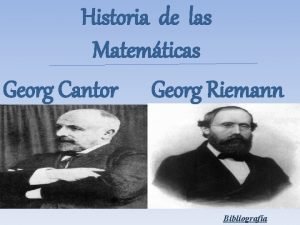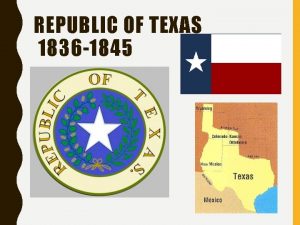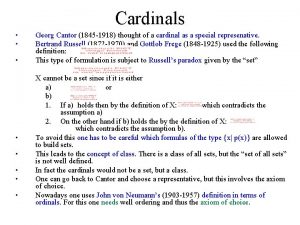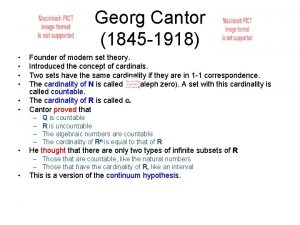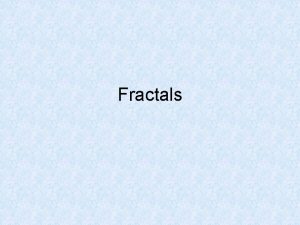Cardinals Georg Cantor 1845 1918 thought of a





- Slides: 5

Cardinals • • Georg Cantor (1845 -1918) thought of a cardinal as a special represenative. Bertrand Russell (1872 -1970) and Gottlob Frege (1848 -1925) used the following definition: This type of formulation is subject to Russell’s paradox given by the “set” X cannot be a set since if it is either a) or b) 1. If a) holds then by the definition of X: which contradicts the assumption a) 2. On the other hand if b) holds the by the definition of X: which contradicts the assumption b). To avoid this one has to be careful which formulas of the type {x| p(x)} are allowed to build sets. This leads to the concept of class. There is a class of all sets, but the “set of all sets” is not well defined. In fact the cardinals would not be a set, but a class. One can go back to Cantor and choose a representative, but this involves the axiom of choice. Nowadays one uses John von Neumann’s (1903 -1957) definition in terms of ordinals. For this one needs well ordering and thus the axiom of choice.

Orders of Sets • A set S is called partially ordered if there exists a relation r (usually denoted by the symbol ≤) between S and itself such that the following conditions are satisfied: • reflexive: a ≤ a for any element a in S • transitive: if a ≤ b and b ≤ c then a ≤ c • antisymmetric: if a ≤ b and b ≤ a then a = b • A set S is called ordered if it is partially ordered and every pair of elements x and y from the set S can be compared with each other via the partial ordering relation. • A set S is called well-ordered if it is an ordered set for which every non-empty subset contains a smallest element.

Ordinals • • • Consider pair (S, <S) of a set S and a well-ordering <S on S. We call (S, <S) and (T, <T) equivalent (S, <S)~(T, <T) if there is a 1 -1 correspondence, which preserves the orders, i. e. a bijection: f: S T, s. t. a<b <=> f(a)<f(b) According to Cantor, the equivalence classes of this equivalence relation are ordinals, abstract from the nature of the elements to obtain the order type. • • • Ordinals can be constructed, from the ZF system. Von Neumann (1903 -1957) constructs ordinals as special types of sets, i. e. representatives A set S is an ordinal if and only if S is totally ordered with respect to set containment and every element of S is also a subset of S. Call (S, <S)<(T, <T) if and only if S is order isomorphic to an initial segment T 1 of T, i. e. there is a k in T such that S~T 1={a|a<k} Ordinals themselves are well-ordered with respect to the order induced by <

Orders on Ordinals and Cardinals • Questions: – Can every set be well-ordered? • Yes (Zermelo), if one assumes the axiom of choice. – Is there an order for ordinals and cardinals? • This is the case for the ordinals and cardinals of finite sets. • Ordinals can be ordered. • Cardinals can be ordered if all sets can be well-ordered which is equivalent (Zermelo) to the axiom of choice.

Arithmetic of Ordinals and the sequence • Let w the ordinal of N in its natural order. • To add two ordinals A=(A, <A) and B=(B, <B) in the following way: A+B: =(AUB, <AUB) where x <AUBy if either 1. x, y A and x<Ay 2. x, y B and x<By 3. x A and y B • Caveat: + is not commutative – 3+w=w – w+3>w Ordinals form a ascending sequence 1, 2, …, w, w+1, w+2, …, w+w+1, … • • Now to each ordinal, we can associate its cardinal. E. g. the cardinal of w is. This is also the cardinal for w+1, w+w Going along the sequence of ordinals, we will however discover more cardinals, one after the other. In this way let be the first new cardinal after and denote the sequence of cardinals obtained in this way by Zermelo showed that assuming the axiom of choice every set can be well ordered. Thus assuming the axiom of choice all cardinals are among the and the cardinals are well ordered.
